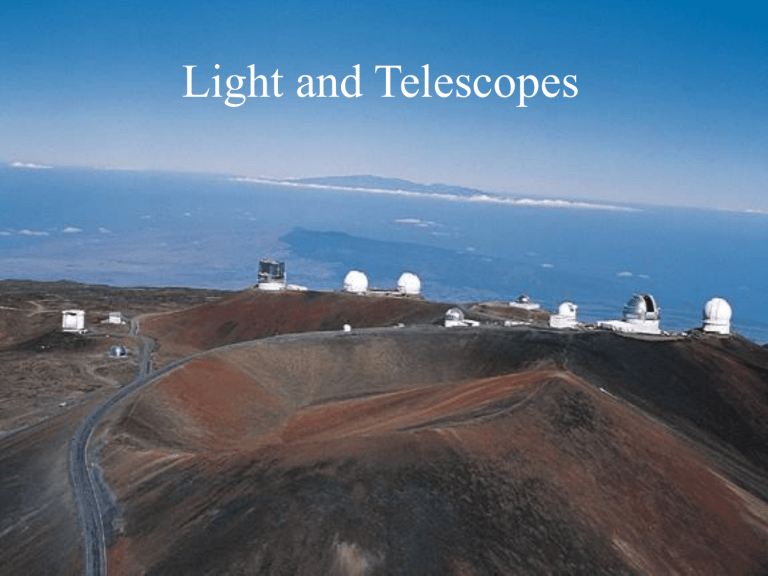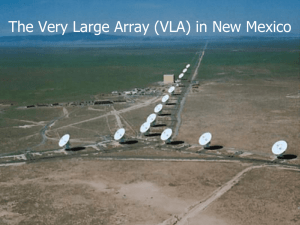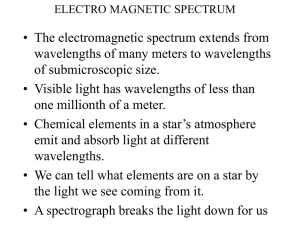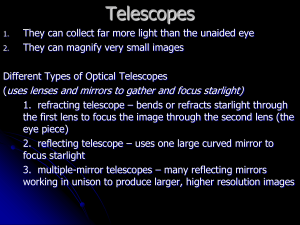Foundation 1 - Discovering Astronomy

Light and Telescopes
What do you think?
• What is the main purpose of a telescope?
• Why do stars twinkle?
What is Light and Why Would
Astronomers Want to Study the
Properties of Light?
• Sometimes we say light is made of waves
•
Sometime we say light is made of particles called photons
•
Moves very fast, at 186 000 miles per second
•
300,000 km per second
• consider a prism ...
If you pass white light through a prism, it separates into its component colors.
long wavelengths
R.O.Y. G. B.I.V
short wavelengths spectrum
Analyzing The Properties of
Light
• Visible Light is but one part of the entire electromagnetic (EM) spectrum.
• EM Spectrum includes all kinds of light
• radio waves (all light moves at the same speed -
• micro waves light speed)
• infrared light
• visible light
• ultra violet light (some light photons have
• x rays shorter wavelengths
• gamma rays and more energy than others)
Visible light is only one type of electromagnetic radiation emitted by stars
Each type of EM radiation travels at exactly the same speed the speed of light!
Not all EM radiation can penetrate Earth’s atmosphere.
Astronomers use different instruments to look at light of different wavelengths - sometimes, we even have to go above Earth’s atmosphere.
SOFIA - the Stratospheric Observatory for Infrared Astronomy
Observations at other wavelengths are revealing previously invisible sights
UV infrared
Ordinary visible
Map of
Orion region
Consider Orion in Different Wavelengths of Light!
http://www.cnn.com/2001/LAW/02/20/scotus.heatdetector.01.ap/index.html
Hubble Space Telescope Views of Orion Nebula showing stars hidden in clouds http://oposite.stsci.edu/pubinfo/pr/97/13/A.html
TODAY’S Sun as seen in visible light from Earth and from space in X-rays by satellites http://solar.physics.montana.edu/tslater/real-time/
Observations at wavelengths other than visible light are revealing previously invisible sights
Visible light image radio wavelength image
High Energy Gamma Rays - Compton Gamma Ray Observatory (GRO) Satellite
The Sky’s emission of Gamma Rays
But, we receive GRBs from every direction !!
The fact that GRBs come from every direction imply that
GRBs don’t come from our galaxy, but from other galaxies spread in every direction!
Radio wavelength observations are possible from Earth’s surface
The Very Large Array (VLA) in New Mexico
Different types of EM radiation require different types of telescopes
• A refracting telescope uses a lens to concentrate incoming light
• A reflecting telescope uses mirrors to concentrate incoming starlight
Analyzing Spectra:
The Properties of Light
• Visible Light is one part of the electromagnetic
(EM) spectrum.
• EM radiation is described as a wave with wavelengths in the range 1x10 -15 m to 100 m.
• Visible light is only a tiny small part of the entire electromagnetic spectrum.
• Little bits of light are called photons.
Dividing Light Into a Spectrum
Astronomers separate out light into its individual components using a diffraction grating or using a prism then they analyze each part independently!
blue 4600 A 81
Filter
Detector
blue 4600 A green 5300 A
81
85
Filter
Detector
blue 4600 A green 5300 A yellow 5800 A
81
85
83
Filter
Detector
blue 4600 A green 5300 A yellow 5800 A orange 6100 A
81
85
83
78 Filter
Detector
blue 4600 A green 5300 A yellow 5800 A orange 6100 A red 6600 A
81
85
83
78
70
The spectrum is continuous.
Filter
Detector
UV IR
Spectra
• Most light sources contain energy in lots of different wavelengths.
• We can measure the brightness in various wavelength bands--the result is called the spectrum.
• The spectrum (total character of light emitted) can tell us a lot about a source.
A refracting telescope uses a lens to concentrate incoming light
Similar to a magnifying glass
A larger objective lens provides a brighter ( not bigger ) image
lenses reverse images
Three main functions of a telescope
• Brighten
(called light gathering power)
• See fine detail
(called resolution) and least important,
• Magnify magnification = (objective lens focal length / eyepiece lens focal length)
Functions of a Telescope
• To gather light.
– want a large objective
– range of few inches to 10 meters!!
• To resolve fine detail.
– limited by size and atmospheric “seeing”
• To magnify
– least important
– about 50x per inch of aperture
(rule of thumb)
Refracting telescopes have drawbacks
• Spherical aberration
• Chromatic aberration
Special achromatic compound lenses and lens coatings can often fix this aberration
Refracting telescopes have drawbacks
• Spherical aberration
• Chromatic aberration
• Sagging due to gravity distorting the lens
• Unwanted refractions
• opaque to certain wavelengths of light
Yerkes Observatory - 40-inch Refracting Telescope:
The Largest Refracting Telescope in the World
Reflecting telescopes use mirrors to concentrate incoming starlight
Newtonian Focus
Prime Focus
Cassegrain focus coude’ focus
Astronomer’s face two major obstacles in observing the stars
• Light Pollution from Cities
• Effects of Twinkling from Earth’s atmosphere
Tucson, Arizona in 1959 and 1980
Earth’s atmosphere hinders astronomical research
Image of stars taken with a telescope on the Earth’s surface
Same picture taken with
Hubble Space Telescope high above Earth’s blurring atmosphere
Rapid changes in the density of
Earth’s atmosphere cause passing starlight to quickly change direction, making stars appear to twinkle.
Advanced technology is spawning a new generation of equipment to view the universe
• CCDs (charge-coupled devices)
• Large telescopes on remote mountain tops
– Mauna Kea in Hawaii
– Cerro Pachon in Chile
• Adaptive Optics to counteract the blurring of Earth’s atmosphere
• Orbiting space observatories
A Charge-Coupled Device
(CCD)
Ordinary Photographs vs. CCDs
Film (negative) CCD (negative) CCD (positive)
Same integration (I.e. exposure) time.
Different quantum efficiency: Film 1% CCD 70%
Matching 10-m, multiple mirror Keck Telescopes in
Hawaii with adaptive optics
High above
Earth’s atmosphere, the Hubble
Space
Telescope provides stunning details about the universe
What did you think?
•
What is the main purpose of a telescope?
A telescope is designed to collect as much light as possible. It also improves resolution and magnifies images.
•
Why do stars twinkle?
Rapid changes in the density of Earth’s atmosphere cause passing starlight to change direction, making stars appear to twinkle.







